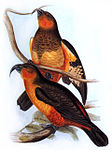Templat:Spesies genus Nestor
| Nestorini | |||
|---|---|---|---|
| Common name (binomial name) status |
Image | Description | Range and habitat |
| Kea (Nestor notabilis) |
 |
48 cm (19 in) long. Mostly olive-green with scarlet underwings and rump. Dark-edged feathers. Dark brown beak, iris, legs, and feet. Male has longer bill.[2] | New Zealand: South Island High-level forests and subalpine scrublands 850–1400 m AMSL.[3] |
| South Island Kaka (Nestor meridionalis meridionalis) |
 |
Similar to the North Island Kaka, but slightly smaller, brighter colours, the crown is almost white, and the bill is longer and more arched in males.[5] | New Zealand: South Island Unbroken tracts of Nothofagus and Podocarpus forests 450–850 m AMSL in summer and 0–550 m in winter.[3] |
| North Island Kaka (Nestor meridionalis septentrionalis) |
 |
About 45 cm (18 in) long. Mainly olive-brown with dark feather edges. Crimson underwings, rump, and collar. The cheeks are golden/brown. The crown is greyish.[5] | New Zealand: North Island Unbroken tracts of Nothofagus and Podocarpus forests between 450–850 m AMSL in summer and 0–550 m in winter.[3] |
| Norfolk Kaka |
 |
About 38 cm long. Mostly olive-brown upperparts, (reddish-)orange cheeks and throat, straw-coloured breast, thighs, rump and lower abdomen dark orange.[7] | Formerly endemic on Norfolk Island and Phillip Island of Australia[8] Rocks and trees[7] |
| Chatham Kaka (Nestor sp.) |
Appearance unknown, but bones indicate reduced flight capability. | Only known from subfossil bones.[9] | Formerly endemic on Chatham Island of New Zealand Forests[9] |
Specific usage aspects
suntingGenus species lists are list of species belong to a specific genus. They are used in order to avoid duplication of work. However, they are not free of issues.
In line citations: The template can include in-line citations. When the whole page is rendered, the template is first inserted, after which the reference list is constructed. In-line citations of the template and the other text are combined in a single list, and references are combined. To avoid duplication of references, the name attribute within each reference tag needs to be the same. It is advised to add the full reference <ref name=xxx>citation</ref> to the template, and use short-cut for repeated citations in the main text <ref name=xxx/>. Two full citations with the same name attribute will be grouped, so duplication of the exact same references is not a problem. However, it is wise to use unique names, in order to avoid two different references with the same name attribute being combined (the first full in-line citation will be used).
The following list of in-line citations are used, and references without a full citation will show up with an error warning:
Begin references
- ^ BirdLife International (2008). "Nestor notabilis". IUCN Red List of Threatened Species. Version 2008. International Union for Conservation of Nature. Diakses tanggal 24 December 2008. Database entry includes a range map and justification for why this species is endangered.
- ^ "Kea - BirdLife Species Factsheet". BirdLife International. 2008.
- ^ a b c Juniper, Tony (1998). Parrots: A Guide to Parrots of the World. Yale University Press. ISBN 978-0300074536.
- ^ a b BirdLife International (2008). "Nestor meridionalis". IUCN Red List of Threatened Species. Version 2008. International Union for Conservation of Nature. Diakses tanggal 24 December 2008. Database entry includes a range map and justification for why this species is endangered.
- ^ a b "Kaka - BirdLife Species Factsheet". BirdLife International. 2008.
- ^ BirdLife International (2008). "Nestor productus". IUCN Red List of Threatened Species. Version 2008. International Union for Conservation of Nature. Diakses tanggal 24 December 2008. Database entry includes a range map and justification for why this species is endangered.
- ^ a b Forshaw, Joseph M. (1981) [1973, 1978]. Parrots of the World (edisi ke-corrected second edition). David & Charles, Newton Abbot, London. ISBN 0-7153-7698-5.
- ^ "Norfolk Island Kaka - BirdLife Species Factsheet". BirdLife International. 2008.
- ^ a b c Millener, P. R. (1999). "The history of the Chatham Islands' bird fauna of the last 7000 years – a chronicle of change and extinction. Proceedings of the 4th International meeting of the Society of Avian Paleontology and Evolution (Washington, D.C., June 1996)." Smithsonian Contributions to Paleobiology. 89: 85–109.
End References